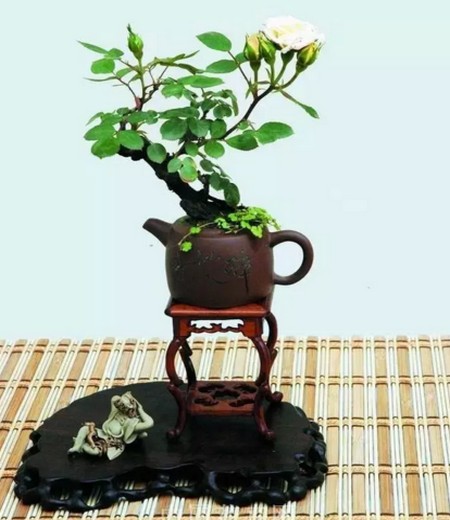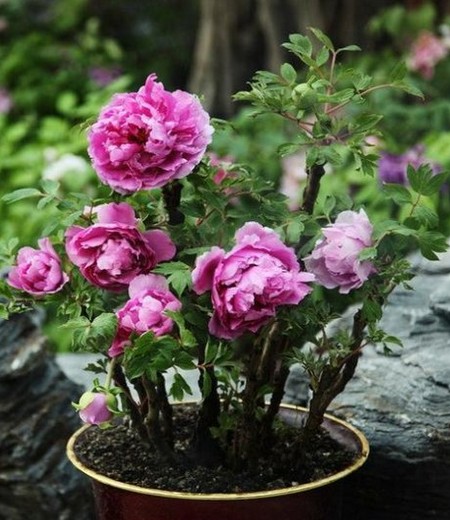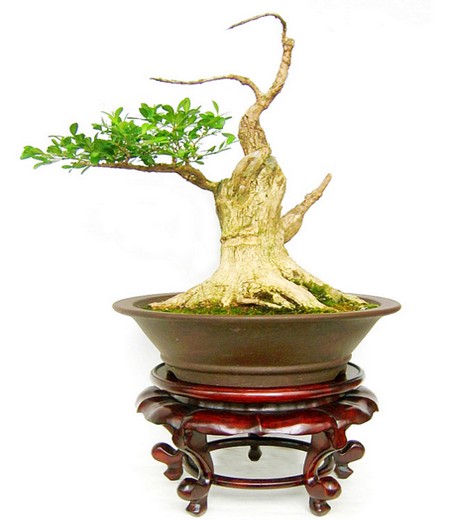Technical points of bonsai production of rose
Rose is a promising bonsai material. The combination of rose and bonsai has not only the natural beauty of bonsai, but also the beauty of rose. A well-made and vivid rose bonsai is a very infectious work of art. Rose flowers colorful, graceful and graceful, known as the "queen of flowers". In addition to potted plants, ground plants and cut flowers, rose can also be used to make rose bonsai. Wake up every morning, see the rose in full bloom on the windowsill, the mood of the day is also very good. The following editor will share with you the material selection and production of rose bonsai. I hope it will be helpful to you!

1. The choice of rose
The rose used to make bonsai requires beautiful flowers, easy flowering, compact plant type, short nodes, small leaves, strong habits, strong germination and resistance to pruning, while color and pattern can be chosen according to personal preferences. Miniature rose is generally the first choice for rose bonsai grafting because of its short plants, small and exquisite flowers, large number of flowers and long flowering period.
2. Selection of rootstocks
Those old roses that have grown for many years and have a quaint and strange shape in landscaping can also be used to make bonsai, which are generally transplanted in winter and spring. Because the main root of rose is developed and the lateral root is rare, the excessively long main root should be cut short before planting, and more lateral roots and fibrous roots should be retained. Planting should be deep, and it is best to bury all the roots in the soil to ensure survival. After planting, keep the soil moist without stagnant water, erase the new shoots that are not needed in modeling after survival, and strengthen the management of water and fertilizer to promote the healthy growth of branches.
3. Pile mining: Qiang Wei pile with peculiar type and natural tip is dug at the side of hillside and ditch every spring. After the pile is harvested, the root trunk is cut in place as far as possible and planted with a little sawdust infiltrated with plain sandy soil. Pot can be planted on the ground, the whole set of plastic bags, after the new buds grow 3cm-5cm, choose rainy days to remove the plastic bags, and then every morning and evening to dry, leaves spray water to ensure survival. Fertilization can be started in August, once every half month, with cake fertilizer and water as the best. The branch transition is natural, the next spring to prune, strengthen management, and so on when the new branches grow to a certain thickness, you can start grafting. Individuals who need to be dried can continue to be stocked.
4. Grafting: it is better to adopt bud grafting in rose bonsai grafting, which is characterized by simple operation, long grafting time, bud grafting from May to September and high survival rate. Visible personal hobbies, choose grafted rose colors and varieties. However, according to my practical experience, it is considered that miniature rose has the characteristics of short plant, small and exquisite flowers, large number of flowers and long florescence, so it is the first choice for grafting. Miniature rose varieties with similar flower patterns can be selected for grafting.
Rose grafting is not difficult, but in order to achieve a higher survival rate, three links must be mastered:
(1) selecting buds. The buds must be taken from strong branches, and it is best to wait until they are about to sprout. It is best to cut off the flowers and fertilize them, release them for a week, and take buds for grafting when the buds begin to sprout.
(2) budding. The common rose adopts the method of peeling and taking buds, and the micro rose branches are thin, so it is not easy to take buds according to the traditional method. We should first cut the shoots close to 2cm length, cut obliquely from the middle part of the back of the bud to both ends, then peel off the cortex from the lower end of the bud, slowly peel off the xylem, and be sure to protect the vascular bundles in the bud. After the bud is removed, according to the high change of the incision of the rootstock, cut the two ends of the bud slice, gently put into the incision of the rootstock, and close to the xylem of the rootstock, wrap it tightly with plastic strips to expose the bud eyes.
(3) moisturizing. After the completion of grafting and bandaging, the grafted rose bonsai can be put into a plastic greenhouse for maintenance if possible, or a single branch can be used to cover plastic bags, which can be directly placed in the natural environment for maintenance. 7Mill can remove the plastic bags in 10 days, untie them, and make up according to the survival situation.
5. Modeling
There are mainly three types of rose bonsai: ancient pile rose bonsai, miniature rose bonsai and combined rose bonsai. Its modelling mainly has the single dry type, a double dry type, the curved dry type, the oblique dry type, the facing water type, the cliff type, the exposed root type, the dry type, the attached stone type, the jungle type, the water drought type, the big tree type and so on different forms, and according to the modeling need, put forward the soil surface of the root, make it hang the root to reveal the claw, simple and vigorous.
Root lifting should be carried out one by one, not too much at a time, so as not to cause the stump to sprout and die. Due to the strong upright branches and large leaves of rose, the crown is generally in natural shape. The modeling method is mainly pruning, supplemented by pulling, so that the branch layout is reasonable, high and low, because its branches are brittle, easy to break, the skin is also easy to tear, so do not bend flat tie.
6. Planting and landscaping
Several robust rose plants are co-planted in rectangular Hu oval flowerpots of appropriate size to make "co-planting rose bonsai" or "water-dry rose bonsai". When planting, pay attention to the collocation of flowers and colors of each rose and the coordination of flowers, stems and leaves, so as to achieve the harmony between positive and oblique, dynamic and static, skillful and clumsy, hidden and dew. finally, it is equipped with spirit stone, trees or other flowers and moss to make it poetic and picturesque.
Time: 2019-05-26 Click:
- Prev

The making method of peony bonsai
Peony bonsai is a new kind of bonsai, which combines magnificent peony with simple and elegant bonsai art to form an art form with unique Central Plains style, which is praised by bonsai experts and scholars in China.
- Next

The method of making bonsai of Populus tomentosa
Poplar bonsai trees are graceful, with leaves as small as beans, thick and shiny, evergreen all the year round, and can be watched all the year round. Yang Pai boxwood bonsai, branches and leaves after cutting processing, into a cloud sheet, as thin as cut, and then embellished with rocks, elegant and picturesque. The young leaves of Populus tomentosa are young in spring, and the trees are green and pleasing to the eye. The ancients sang Huang Yang's poems
Related
- Fuxing push coffee new agricultural production and marketing class: lack of small-scale processing plants
- Jujube rice field leisure farm deep ploughing Yilan for five years to create a space for organic food and play
- Nongyu Farm-A trial of organic papaya for brave women with advanced technology
- Four points for attention in the prevention and control of diseases and insect pests of edible fungi
- How to add nutrient solution to Edible Fungi
- Is there any good way to control edible fungus mites?
- Open Inoculation Technology of Edible Fungi
- Is there any clever way to use fertilizer for edible fungus in winter?
- What agents are used to kill the pathogens of edible fungi in the mushroom shed?
- Rapid drying of Edible Fungi

